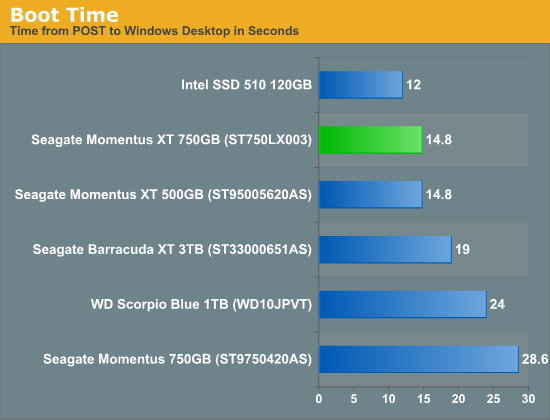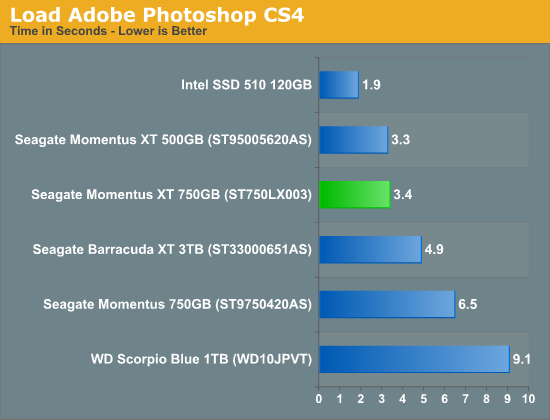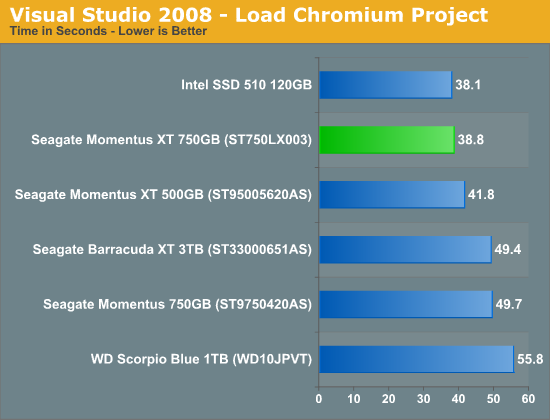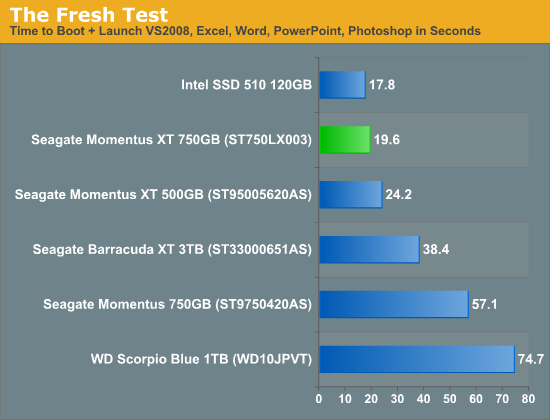Seagate 2nd Generation Momentus XT (750GB) Hybrid HDD Review
by Anand Lal Shimpi on December 13, 2011 12:51 AM EST- Posted in
- Storage
- Seagate
- Momentus XT
- Hybrid Drive
- HDDs
- SSHDs
Once More, With Feeling
Just as we did in our original Momentus XT review, we'll start with a look at some hand-timed application tests.
First up is a good old fashioned boot test. I measured boot time on our testbed from POST to first seeing the mouse cursor on the Windows 7 desktop. This isn't a timing of actual boot-to-use since more loading happens even after you get to the desktop, but it does encapsulate much of the Windows 7 boot process.
All tests were repeated until performance leveled off. In the case of an SSD, this was after just one run. In the case of the 500GB Momentus XT, it took five runs to get there, whereas the second generation model was there after just two. The traditional hard drives each took a few runs for their performance to stabilize as well due to Windows 7's own boot optimizations taking effect.

Boot performance continues to be very impressive on the Momentus XT. It's still not quite as fast as a high end SSD, but it's definitely faster than a traditional hard drive (even a faster, 3.5" model). With a larger NAND cache, your boot time is more likely to remain this low even as other applications and data are pulled into the cache.
Next let's look at a simple application launch test. Adobe Photoshop continues to be one of the more stressful workloads for a hard drive, even down to launching the application. Here I measured from the time I clicked on the Photoshop icon in the Start Menu to first appearance of the blank Photoshop canvas and toolbars. Again, I repeated this test until performance leveled off in all cases.
For the Momentus XT performance fluctuated and it never truly settled on a single launch time. Performance started out at over 5.6 seconds but for all runs after the 2nd launch time ranged in the upper 2s - upper 3s. For its results as well as those from all of the hard drives, I averaged five launch times and presented those averages. The lone SSD in this comparison delivered consistent performance across all runs.

Here the Momentus XT continues to do very well, for a hard drive. It's faster than any of our mechanical drives, and significantly faster than your run-of-the-mill 5400RPM 2.5" drive for sure. A good SSD is still around 70% faster than the Momentus XT.
When constructing our Visual Studio 2008 project build benchmark for our CPU reviews I was reminded just how much of a pain it is to do development work on a system with a hard drive. I tried using the same benchmark to measure drive performance however it seems I used too good of a CPU benchmark as disk performance plays a small role in actual compile time here. Instead I looked at the impact of disk performance on loading the Chromium project in VS2008. I used the same test rules as before, presenting performance once it has leveled off for all drives involved. Once again, the SSD delivered peak performance after a single run. The Momentus XT was able to do it after 2 - 3 runs. Performance didn't improve over multiple runs with the traditional hard drives.

There's a clear division between the NAND equipped Momentus XTs and the traditional hard drives here, but not so much between the former and the Intel SSD 510. I can definitely understand Seagate's temptation to draw the comparison to the performance of an SSD. The problem with doing this is highlighted in my comments above however. While the SSD always performed to the best of its abilities in our tests, regardless of the number of times I ran a test, the Momentus XT needed a couple of runs to get to that point. The NAND cache isn't overly predictive and as a result the first time you do almost anything the Momentus XT will perform like a traditional 7200RPM 2.5" hard drive. Given a light enough workload, the Momentus XT should be able to eventually fit much of the most frequently read data into its cache, but the process of actually getting there can still be painful.
For our last application level benchmark I turn to something I've used since the early days of SSD reviews: the fresh test. Take our boot test from earlier, and string together a series of application launches after you hit the desktop. In this case I'm launching Excel 2007, PowerPoint 2007, Word 2007, Visual Studio 2008 and Photoshop CS4 as soon as the system boots. I measure the time from POST until the last application is completely launched. I call this the fresh test because when you first build a machine everything, even on a traditional hard drive, performs quickly. Load up a lot of applications and use your system for a while and you'll soon notice that things aren't quite as snappy any more. Defragmenting your drive can help but after a certain point it's the bloat of everything installed that really limits performance. A better test would be to use an image that was months (if not years) old, but I've found that this benchmark gets the job done. Lower numbers here translate very well to a snappier system and one that feels new regardless of what you've got loaded on it. SSDs truly excel in the fresh test, but what about the Momentus XT?

Surprisingly enough, the Momentus XT does extremely well. The newer model clearly does a better job of keeping more data in NAND, but both are head and shoulders above the traditional hard drives. If you have a fairly regular usage pattern (E.g. you always run the same 5 or 6 applications), the Momentus XT can significantly improve the overall user experience. In some cases, it can even approach the performance of an SSD.










98 Comments
View All Comments
7Enigma - Thursday, December 15, 2011 - link
2 drives completely separate. Have your OS and frequently used programs/games on the SSD (this obviously can vary widely due to SSD size), and store the remaining media on the traditional HDD. This is how I and many people use it.I have a second gen 80GB Intel drive as my boot/programs/select game(s), and then everything else is on a separate drive.
mmaenpaa - Tuesday, December 13, 2011 - link
Hi,Just wanted to chip in. I have installed tens of these (meaning older revision Momentus XT) to our customer's PCs. Normally user's store stuff just where it goes and that place beings systemdrive. Using two different partitons even is usually too advanced for average user. Trust me, I have 20 years of experience from the days we installed 40MB drives into PC's.
Intel RST (SSD + MECH HDD) solves this nicely, but we have only put one of these out there. And of course one unfortunate power outage meant a trip to our office. As the user did not know how to recover from this (and frankly I had to use a bit of time also). Of course we had only the read caching version enabled but still not very (average)enduser friendly solution.
Momentus XT also fits very well on normal usage which is suprise suprise:
power on computer
wait for desktop
start outlook (corporate users)
start internet browser
start your erp (corporate users)
do some ligth editing with office
Read only works wonders with this setup.
Reliability has so far been excellent. I have about 40 pieces out there and I have possibly one flaky one (not verified yet). I have had problems installing to a few laptops old and new, then again I've had major problems with SSD (SFORCE2 & Intel 320). Most of them bios related, some sandforce related.
I have sold maybe 30 SSDs. One (Corsair NOVA series 64GB) broke totally (thanks to Ibas & 2500€ almost all data was recovered), one has been rma'd and two more are waiting for RMA process. So in my book I still like mechanical drives, they seldom brick themselves totally like this one SSD did.
Any way, I'll be putting mostly the older modelMomentus XTs into the machines. At this price point it is just too exepensive for corporate desktop (or home desktop). I'll wait for the write caching and a bit lower price point.
BR,
Markku
Denithor - Tuesday, December 13, 2011 - link
Install OS + programs on the SSD, remap Documents/Music/Video/etc into folders on the secondary HDD. That way if the SSD bricks it doesn't affect their "saved" files and there's no user data at risk.Of course, the secondary HDD isn't proof against failure, which is why I always recommend people back up regularly. They seldom do, but hey, then I can say 'I told you so.'
:)
Denithor - Tuesday, December 13, 2011 - link
Didn't they opt for 16+GB of MLC NAND and enable the random write firmware? With a good (even mediocre) controller writes shouldn't be a problem, the cost would be equivalent and they actually could give true SSDs a run for the money with the writes enabled. Combine this with a large capacity (1-2TB) platter drive and you'd have a winner!I'm guessing you guys (Anand) are under NDA for the write-enable firmware results?
AMv8(1day) - Wednesday, December 14, 2011 - link
Love the review, unfortunately I think the market landscape has changed enough with the cost of even the most expensive 120/8GB SATA 6Gbit/s SSD's falling below the cost of one of these, and the fact that you can pick up 2 2.5in 1TB external drives for the price of one of these, I only see a few scenarios where this drive could be beneficial.1) In a SFF box with 1 3.5 bay, RAID two together in a 2.5 to 3.5 adaptor to have one very fast 1.5 TB drive, provided the read/write caching scales well, that would effectively give most more than enough storage space without having to compromise with separate drive mapping or slower storage access. And it would provide the OS the 16GB of SLC NAND you feel it needs. Oh, and aprox. 380GBs more space than a 120GB/1TB SSD/HDD combo.
2) I would really like to see a comparison between this setup and all of the different software/hardware caching/Rapid storage technologies (Intel Rapid Storage Technology, LSI's CacheCade software & WarpDrive 2 Hybrid, OCZ's Synapse Cache SSD & RevoDrive Hybrid, and any other versions/implementations I'm missing.
Thoughts anyone? Anand? Thanks a lot for your articles, I've really enjoyed them.
navaneethg - Wednesday, December 14, 2011 - link
So, Processor -> Instruction cache -> L1 Cache -> L2 Cache -> RAM -> SSD "Cache" -> slow drive.That's a lot of cache to deal with. I guess in the library analogy above, the library will be filled with help desks within help desk within help desk .. :)
AMv8(1day) - Wednesday, December 14, 2011 - link
There's also RAMDisk in there!Denithor - Thursday, December 15, 2011 - link
You forgot the L3 Cache.:)
Shadowmaster625 - Wednesday, December 14, 2011 - link
There is no way and no reason a frickin $37 HDD and a $42 SSD should combine to cost $150 more than the sum of their parts. That's just a crock. Who the hell pays $250 for this trash when you can buy 200gigs of pure SSD for that much money? Highway robbery.bse8128 - Wednesday, December 14, 2011 - link
You briefly mention Intel RapidStorage, but unfortunately there's no benchmark of the regular Momentus with RST...